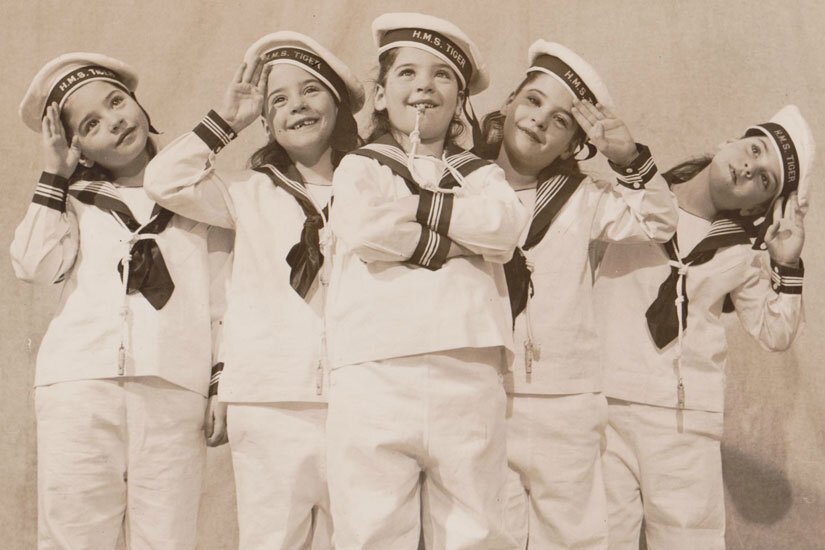They were five: the Dionne quintuplets
It’s tempting, during Canada’s 150th birth year, to bask in our “sunny ways” and celebrate only the positive. But is a nuanced appreciation of what it means to be Canadian even possible without also examining our failings as a nation, including official decisions that have aged terribly? To understand an integral part of the Canadian legacy, we must look to five little girls born on May 28, 1934.
The Dionne quintuplets, born to French-Canadian parents Oliva-Edouard and Elzire near the village of Corbeil, Ontario, fascinated people around the world as the only quints to survive beyond a few days—a medical marvel of the time. Before they ever took their first steps, Annette, Émilie, Yvonne, Cécile and Marie became symbols of humanity’s undefeatable spirit during the Depression.
The Dionnes were already “dirt-poor” parents of five when Elzire became pregnant with the quints. The babies arrived two months premature, surviving a home birth at a combined weight of less than 14 pounds. They received near-constant care as newborns—the Red Cross sent nurses and incubator, and women from neighbouring villages donated milk—while word of their existence spread like wildfire.
While they were still infants, the quints’ parents—whose poverty is emphasized in every telling of the Dionnes’ tale—entertained a request from Chicago’s Century of Progress exhibition to put them on display. When the quints were four months old, the Ontario government stepped in to remove them from Oliva and Elzire’s custody, citing fear of exploitation.
The girls were installed across the road from their family home at a specially designed hospital. The obstetrician who delivered them, Dr. Allan Roy Dafoe, hovered over them with his medical staff. The sisters would become closely observed wards of the province, and made to live inside what became known as “Quintland”—a rural spectacle that drew 3 million visitors between 1936 and 1943. Hordes of onlookers came to watch the girls play behind one-way glass.
If there was any sense of public outrage toward the treatment of the Dionnes, the numbers didn’t reflect it. Quintland became one of Canada’s biggest tourist attractions, and a $500 million asset to Ontario. The windfall came at the tail end of the golden age of the theme park, and capitalized upon popular preemie exhibits, then common at fairs across North America. However, the girls’ earning potential wasn’t just confined to the walls of Quintland: their likeness was used to advertise everything from condensed milk to toothpaste, and they were the subject of three feature films and several documentaries.
All the while, the quints’ parents fought to put an end to the girls’ exploitation: the very thing they’d been taken away to prevent. Custody was returned to Oliva and Elzire when their daughters were nine years old. The girls left the Quintland compound forever—but unfortunately, their struggles didn’t end there. Back at home, they faced emotional and sexual abuse, as they would later allege in a book they coauthored, 1997’s The Dionne Quintuplets: Family Secrets. At 18, they left their parents’ home and broke off most contact with their family.
Meanwhile, despite the enormous revenues they had generated during their time in Quintland, the trust started for the Dionnes only had $1 million in it—$800,000 of which remained by the time they turned 21 and became able to access the money. By then, one sister had already passed away: Émilie died at 20 due to complications caused by a seizure. Marie made it to 35 before succumbing to a blood clot.
While they spent most of their adult lives out of the spotlight, the Dionnes made headlines again in the nineties, when it was discovered the three remaining sisters, then in their sixties—Annette, Cécile and Yvonne—were living in suburban Montreal on a combined income of $746 a month. In 1998, after initially claiming it had no legal responsibility toward the quints, the government bowed to public pressure, formally apologized to the remaining sisters, and paid them a settlement reportedly worth $4 million.
Even after the remuneration, the sisters could never quite escape the corrupting influence of money. In 2016, an oil painting of the quintuplets by Gil Elvgren was auctioned off in Toronto to benefit Cécile, whose son had already disappeared with her portion of the settlement, leaving her penniless.
Last month, just days before their 83rd birthdays, the surviving sisters, Annette and Cécile (Yvonne passed away in 2001), stepped into the spotlight one more time to beseech the government to ensure their birthplace, which has become a museum, has consistent funding, and to ask it to do more to prevent child abuse.
“For our birthday,” Annette told the Canadian Press in an interview at her home, “we wish that Canada would take better care of their children.”
This story first appeared in Passport2017, a Strategic Content Labs and Heritage Canada project.
